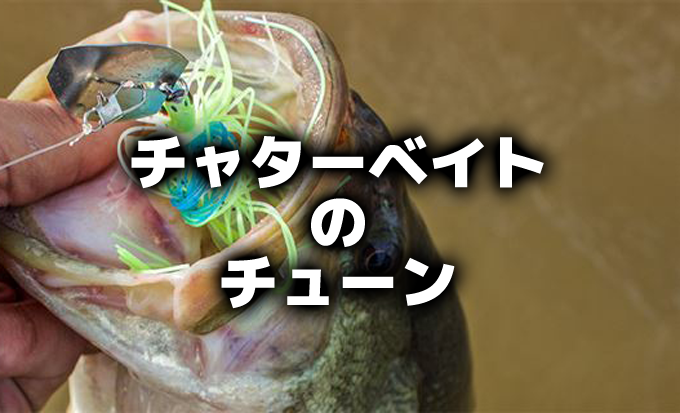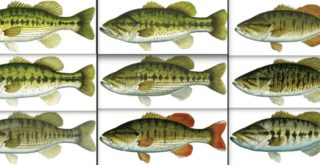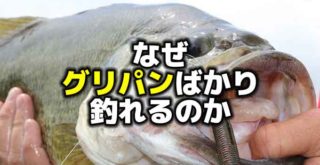ルアーの出す振動(波動)と音について

Photo by midwestoutdoors.com
こんにちは!店長の小山です!
本日は海外サイトより、”THE VIBRATION FACTOR”という記事を引用してご紹介いたします。
引用先:midwestoutdoors.com”THE VIBRATION FACTOR”by DAN BROZOWSKI LARGEMOUTH, MAY 15, 2018(海外サイトです)
皆さんは、ルアーの出す波動や音について、どれほど重要視されていますでしょうか。
釣具屋さんに行ってルアー売場を歩いていると、そのカラーの多さに圧倒されますが、その中から好きなカラーを選んで手に取ってみます。これにしようかなーと思ってパッケージを良く見ると「サイレント」と書いてあり、「サイレントかい!」と思って売場に戻すことがあります。つまり、まずはカラーがあって、その次に音について考えるというパターンです。
私の場合はだいたいそうなります。
それから、買ってみたルアーを実際にフィールドで泳がした時に初めて「あ、このルアー、コトコト系の音なんだ」と思ったり、「思ってたより振動が強いな」と思ったりもします。
売場でルアーを振ってみればラトル音ぐらいは分かるものなのに、なぜかそれをしないことが多いんですよね…。
まあ、ここまでこんなことを書いておいてなんなんですが、私の場合、結局のところサイレントモデルの方が好みだったりするので、サイレントモデルならそれはそれでいいんですけどね…(笑)
この記事は、アメリカ中西部を中心とした総合アウトドアメディア「MIDWEST OUTDOORS」のもので、ルアーの出す振動や音について解説されています。
意外と音や振動については無頓着になりがちな部分ですから(私だけだといいのですが)、どういうところに気を付ければいいのか、ここでひとつ学んでおいてみてはいかがでしょうか。
バスと音
I’m not a fisheries biologist, nor am I quoting from a study, I’m just giving you my take on the subject based on trial and error, a basic knowledge of fish anatomy, and whole lot of years spent with rod and reel in hand.
So with that disclaimer, let’s take a look at the importance of vibration and sound.
All baits—and natural prey that move through the water column—emit some type of sound or vibration. That’s whether they create a surface disturbance, crawl along the bottom or move at any depths in between. Bass and most other predators are highly sensitive to these sounds. These sounds and vibrations, whether created by natural forage or your bait trying to replicate natural forage, are one of the key components that trigger bass to strike.
I firmly believe that the vibration broadcast from your bait has more influence on whether a bass engages it than a chosen color pattern does.
Before getting into bait choices, we first must understand how are bass home in on a bait, often long before they see it.
Once again, not too scientific here, but bass can sense sound and vibration. They accomplish this through ears located to the rear of their eyes, above the gill plate and through another sensory mechanism called the lateral line. This is a system of tactile sense organs located in the head and along both sides of the body, used to detect movement and vibration in the surrounding water. The lateral line, a fascinating mechanism, is more crucial to the detection of sound and vibration than the ear.
In water without visibility, the lateral line is the organ that puts food in their bellies.
I remember reading a piece from the late Doug Hannon (The Bass Professor), who, in my opinion, was the greatest big bass angler of all time, an incredible tackle innovator and researcher. He wrote about catching many older bass in the 10-pound range that had no eyesight. These visually impaired creatures, totally unable to see their targets, had survived to reach trophy proportions. How? By using their lateral lines.
An angler’s first reaction might be to appeal to that lateral line with the nosiest of baits on the market. That might sound logical, but it’s not that simple.
Yes, when you’re fishing waters with low visibility, a bait with increased sound and vibration might be the ticket. But at certain times a more subtle or quiet approach might be more productive. When it comes to clearer water, I’ve found that too much sound often spooks bass rather than draws their interest. As we look at a few baits here to understand the vibration factor, keep in mind that none of these suggestions are foolproof. Fish will make a fool of you if you are not willing to experiment.
私は漁業生物学者ではありませんし、研究から引用しているわけではありません。これまでの多くの年月をかけてロッドとリールでの試行錯誤で得た知識、魚の解剖に基づいた基礎知識をもって、皆さんにお伝えしようと思います。
そのあたりをご理解いただいた上で、振動と音の重要性を考えてみましょう。
すべてのルアーと水中を通って移動する自然の生物は、何らかの種類の音や振動を発します。それは、水面をかき乱したり、ボトムに沿って這わせたり、その中間のあらゆるレンジで動いたときもです。バスやその他のほとんどの捕食者は、これらの音に非常に敏感です。これらの音と振動は、自然の生き物であれ、自然の生き物を模したルアーであれ、バスが襲うきっかけとなる重要な要素の1つです。
私はバスが追ってくるにはしっかりとしたカラー選びよりも、それが出す振動の方が多くの影響を与えていると確信しています。
ルアー選びに入る前に、まず私たちはバスがルアーを眼で見る前にどのようにルアーの存在に気付くのかを理解しておく必要があります。
改めて、科学的根拠があるわけではありませんが、バスは音と振動を感じることができます。彼らは目の後ろとエラぶたの上にある内耳、および側線と呼ばれる別の感覚器官を介してこれを検知します。これは頭の中および身体の両側に位置する触覚器官のシステムで、周囲の水の動きや振動を検出するために使用されます。魅力的なメカニズムである側線は、耳よりも音や振動を検出するために重要なものです。
視界の悪い水域では、側線は食物を食べるための器官であるとさえ言えます。
私は、私にとってこれまでで最も偉大なバスアングラーであり、信じられないほど革新的な取り組みをする研究者であった故ダグ・ハンノン(バスの教授)の論文を読んで覚えていることがあります。彼は、視力を失った10パウンダーのバスを釣り上げた時のことについて書きました。この視覚的障害を持つバスは、獲物を完全に見ることができないながらここまで生存し、トロフィークラスまで成長しました。どうやってでしょうか?彼の側線を使用することによってです。
釣り人がするべき最初の行動は、市場に出ているルアーの中で最も大きな音で側線にアピールするものを買うことかもしれません。これは理にかなっているように聞こえるかもしれませんが、実はそれほど単純でもありません。
そうです、視界の悪いフィールドでは、音や振動が多いルアーが良いと思います。 しかしある時は、より繊細で静かなアプローチの方がより効果的になるかもしれません。 クリアウォーターのフィールドでは、多くの音が彼らの興味を引くのではなく、むしろバスを怯えさせていることが分かりました。 振動のことを理解するために、ここではいくつかのルアーを紹介します。ただこれらの解説はどれも絶対に確実なものではないことに注意してください。 「下手の考え休むに似たり」ということわざがあるように、まずは実験あるのみです。
ルアーごとの振動や音
We’ll talk about surface baits in a future column and focus on subsurface presentations here.
When it comes to vibration and sound and having a variety of performers from noisy to subtle, the bait type that covers that whole spectrum of vibration are crankbaits. From lipless rattling cranks, to shallow cranks on down to the bottom dredgers, they offer the bass angler a huge selection of sound producers.
It’s impossible to tell you which version crankbait to throw and when, but I will toss out a few suggestions. For my approach, the clearer the water I’m fishing, the less I rely on sound. Most cranks have noisy rattle chambers, but there are a few “silent” baits, many made of pure balsa. For the most part I like baits with a little less sound coming from built-in sound chambers. Bass have no problem hearing and sensing the wobble of a crankbait and the sound produced by rattling trebles is more than enough sound for most waters.
Another aspect to keep in mind is the thinner the lure’s body, the less the vibration it usually emits. The fatter or wider bodied baits have a bit more wobble and produce more vibration. The diving lip plays a part in vibration too, so consider all these factors. If you have a vibrating bait, you can feel the vibration through your rod. This is a simple way to actually feel the difference in vibration levels of various baits. The more rod thump, the greater the vibration output of that bait. Easy test.
Jump to spinner baits, another great style of bait that runs the gamut of vibration output. Blade style helps determine the amount of vibration produced. The rounder the blade the more thump it creates in the water. Thinner, narrower blades create less vibration. Either can be a great choice depending on the water conditions.
Jigs and plastics that move along or contact the bottom also create sound and vibration. Whether or not they have rattles, bass can sense these bottom intruders. If they can sense a crawfish walking on the bottom, they can sense your bait as well. Personally, I don’t often use jigs with rattles, bass can find a jig bumping bottom or off wood and rock without much added sound. Heavily stained water might give the rattling jigs a bit of an advantage. Like always, experiment.
Other bottom baits like worms and creature baits create some sound and vibration when worked on the bottom, too. Keep in mind, the thicker or heavier the plastic body, the more water it displaces, which creates more sound. Although one might think that soft plastics are silent, these baits still attract fish with their vibration.
Well that’s a wrap for this month. My hopes are that these concepts would shed a bit more light on the effects that vibration and sound play when trying to appeal to a bass’ natural instincts. I also hope you realize that bass use a hunting mechanism beyond sight to locate their prey.
トップウォータールアーに関してはまたの機会にするとして、ここでは水中のプレゼンテーションに焦点を当ててみます。
振動や音を出し、うるさいものからサイレントのものまでさまざまな種類があり、あらゆる振動の種類を網羅するルアーと言えばクランクベイトです。ラトル入りリップレスクランクやシャロークランクからボトムを叩くよう潜るものに至るまで、彼らはバスアングラーに多くの音に関する選択肢を提供します。
いつ、どこで、どんなクランクを投げればいいかについてまではお話しすることはできませんが、いくつかの提案はあります。私のアプローチでは、釣りをする水がクリアなほど、音には頼りません。ほとんどのクランクにはラトルルームがありますが、バルサ製の “サイレントルアー"もいくつかあります。ほとんどの場合、私はサウンドチャンバーに組み込まれたラトル音が少ないルアーの方が好きです。バスはクランクベイトの波動を聞き取って感知するだけで問題はなく、ラトルによる高音は、ほとんどの水に対して余分な音になります。
ルアーのボディは薄ければ薄いほど、通常は振動が少なくなります。より太くてワイドなボディのルアーは揺れが大きくなり、より多くの振動を発生させます。リップも振動の一部を担いますので、これらすべての要素を考慮してください。ルアーの振動は、ロッドを介して感じることができます。これは、様々なルアーの振動レベルの違いを実際に感じる簡単な方法です。ロッドへの衝撃が強いほど、そのルアーの振動出力は大きいということです。簡単なテストです。
すべての振動を繰り出す素晴らしいルアーのひとつ、スピナーベイトの話に参りましょう。ブレードの形状を見ることで、発生する振動の量を測るのに役立ちます。ブレードが丸くなるほど、水の中に大きな振動ができます。薄くて幅の狭いブレードは振動を少なくします。いずれの場合も、水の状態に応じて最適な選択となります。
ボトムを這わせたりコンタクトさせるようなワームやジグも、音と振動を発生します。それにラトルがあるかどうかにかかわらず、バスはこれらボトムへの侵入者を感知することができます。彼らがボトムを歩くザリガニを感じることができるのと同様に、あなたのルアーも感じることができます。個人的には、私はジグにラトルを使用することはありません。バスはあまり音を追加せずとも、ボトムや木や岩を叩く音でジグを見つけることができます。濁りの多い水であれば、ジグにラトルを付けるとこは少しのアドバンテージになるかもしれません。これもまた、実験ですね。
ワームやクリーチャーベイトのような他の底物系ルアーも、ボトムで動かせばいくらかの音と振動を発生します。ワーム本体の大きさや重さが大きいほど、より多くの水を動かし、より多くの音を発生します。ワーム類はサイレントであると思われるかもしれませんが、これらのルアーもやはりその振動で魚を引き付けます。
今回はここまでです。私の望みは、バス本来の本能にアピールしようとするとき、振動や音などこれらのコンセプトが捕食に関わっていることについてもう少し光を当ててほしいということです。私はまた、バスが自分たちの獲物を見つけるために視力を超えたハンティングの仕組みを使うということを実感してほしいのです。
いかがでしたか。
たまに、釣ったバスの眼が潰れていたりして、痛々しい思いをすることって、ありますよね…。痛々しいと思うと同時に、生きることへの執念を感じたりして、バスをリスペクトしたりもします。
そういうバスは視力に頼らずエサを獲っているわけで、目だけじゃない部分の機能の精密さというか、身体能力の高さには驚きますよね。
それほど、ルアーの出す音や波動というものは重要なんだと、よく分かる記事だったと思います。
ちなみに音というのは、言い換えれば振動です。私たち人間が聞く音というのは空気の振動ですから、バスが聞く水中の音は、水の振動です。そこで私は、バスはラトルのような高周波の音は頭の中の内耳で聞き、ルアーや生き物の出す波動のような低周波は側線で聞いていると思っています。
つまり、頭(記憶)で「食べよう」と思うのが内耳で聞いた時で、本能(反射)で「食べよう」と思うのが側線で聞いた時なのだと思っています。ですので、記憶に残りやすいラトルの音は私のようなものが使うと見切られやすいと思い、サイレントのルアーが好きなんです(笑)
ネガティブな考えかもしれませんが、結局そう考えることが楽しいので大丈夫です(笑)
とはいえ、カラーも重要です。
好きなカラー、信頼できるカラーに頼りつつも、次からはルアーのパッケージを振ってみて、ルアーの出す音に注目しながら買ってみると、ルアー選びにもっと深みが増すのかもしれませんね。
当店は通販専門店ですので、お客様にルアーを振って買っていただくことはできませんが(しまったこの記事を掲載したのは売り上げダウンになってしまうか)、自分が信頼できるルアー選びや好みの音を見つけるという作業も、ルアーフィッシングの楽しみのひとつだと思いますので、ぜひやってみて下さい。
それでは、また。
毎度ありがとうございます!




























